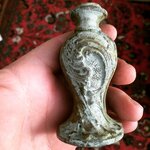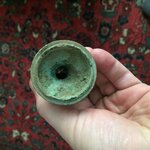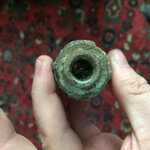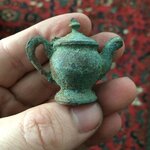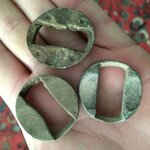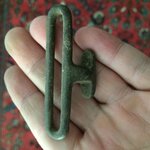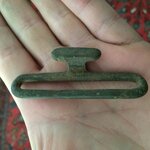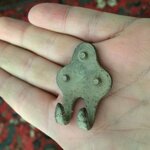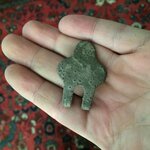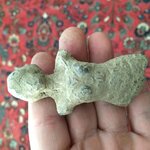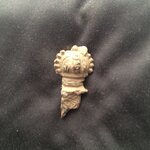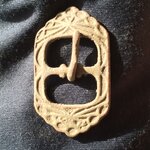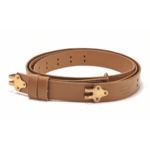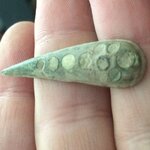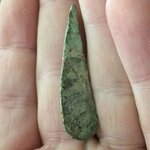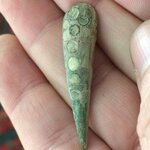Navigation
Install the app
How to install the app on iOS
Follow along with the video below to see how to install our site as a web app on your home screen.
Note: This feature may not be available in some browsers.
More options
You are using an out of date browser. It may not display this or other websites correctly.
You should upgrade or use an alternative browser.
You should upgrade or use an alternative browser.
Catch up post
- Thread starter oxbowbarefoot
- Start date
Erving
Hero Member
oxbowbarefoot
Banned
- Thread starter
- #3
Could the little crown topped pewter thing in the second to last picture be a broken piece off the top of a pouch badge or plate?
CTwoods
Sr. Member
Those three brass circles with a crossways rounded seat... no clue, but I recently dug one that is slightly more refined. Can't date my site yet, but I found late 1600s to late 1800s items, so no help there.
oxbowbarefoot
Banned
- Thread starter
- #5
The item in pic 8 & 9 looks like the adjustment hook of the sling I had on my M14..
View attachment 1272846
it could be, that looks like a good match. The plenty of hunters and recreational shooters use the area where I found it.
oxbowbarefoot
Banned
- Thread starter
- #6
I know the top one is a brass candlestick, hopefully someone might recognize the patter on it. And I don't think the little lamp thing is too old. Probably early 20th century is my guess.
oxbowbarefoot
Banned
- Thread starter
- #7
CTwoods, I have probably found a dozen of them, always at older sites. However, most of the older sites I hunt have seen continuous use since settlement. I did find a couple near cellar holes that haven't been occupied since very early 1900's
Erving
Hero Member
Those three brass circles with a crossways rounded seat... no clue, but I recently dug one that is slightly more refined. Can't date my site yet, but I found late 1600s to late 1800s items, so no help there.
I always thought those were the end caps to old hand tools like a rake, hoe or sickle where the iron end goes into the wooden handle so the wood wouldn't split.
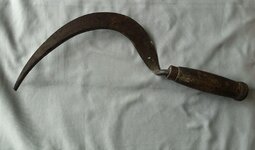
CTwoods
Sr. Member
I always thought those were the end caps to old hand tools like a rake, hoe or sickle where the iron end goes into the wooden handle so the wood wouldn't split.
View attachment 1272850
I'd need to go find mine to look at the backside....but....you did stir my mind a bit. :
Could it possibly be the base of where the short stubby wood handle fits onto a typical 2-hand longer hay scythe
 Would that explain why there is a crossways rounded seat, so that would be the side that sits on the main wooden long shaft?
Would that explain why there is a crossways rounded seat, so that would be the side that sits on the main wooden long shaft?CTwoods
Sr. Member
I'd need to go find mine to look at the backside....but....you did stir my mind a bit. :
Could it possibly be the base of where the short stubby wood handle fits onto a typical 2-hand longer hay scytheWould that explain why there is a crossways rounded seat, so that would be the side that sits on the main wooden long shaft?
Here is the biggest pic I found. I can't see if there is a crossways curved seat, but hope you can see better that I can.
Attachments
CTwoods
Sr. Member
Ooops, I forgot to say, that on the site I found that brass circle, I did find the special hand sharpening stone that was made exclusively for these "long bladed" scythes. It is a fine stone carried in the field, that is a foot or more long, and is tapered like a blunt spear on both ends.
Does not mean the brass thing goes to a scythe, but does prove that this site definitely had a scythe.
Does not mean the brass thing goes to a scythe, but does prove that this site definitely had a scythe.

oxbowbarefoot
Banned
- Thread starter
- #12
I found most of mine in farm fields, or associated with tool parts around cellar holes I think Erving's hypothesis is a pretty good one.
oxbowbarefoot
Banned
- Thread starter
- #13
trapperart
Gold Member
- Dec 12, 2015
- 16,162
- 13,042
- 🥇 Banner finds
- 2
- Detector(s) used
- whites MXTPro whites MXSport
- Primary Interest:
- Metal Detecting
Very nice finds congrats
CRUSADER
Gold Member
I like the toy Tea Pot!
The Pewter/lead-alloy crown is part of the top of a German crown perfume bottle - circa 19th C - early 20th
The Pewter/lead-alloy crown is part of the top of a German crown perfume bottle - circa 19th C - early 20th
against the wind
Gold Member
- Jul 27, 2015
- 24,797
- 24,979
- 🏆 Honorable Mentions:
- 1
- Detector(s) used
- E-trac, Excalibur, XP Deus, & CTX 3030.
- Primary Interest:
- All Treasure Hunting
Very nice hunt, I was thinking that the 3 circular slotted caps might be end caps for blade type fuses. Kind of big though.
Congrats.
Congrats.
oxbowbarefoot
Banned
- Thread starter
- #20
Thanks for all the ID's Crusader. I appreciate it.
Users who are viewing this thread
Total: 2 (members: 0, guests: 2)
